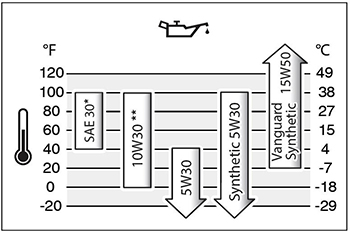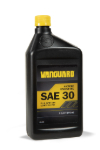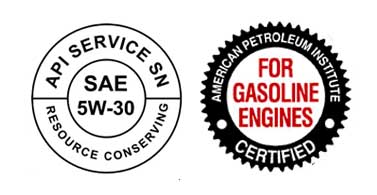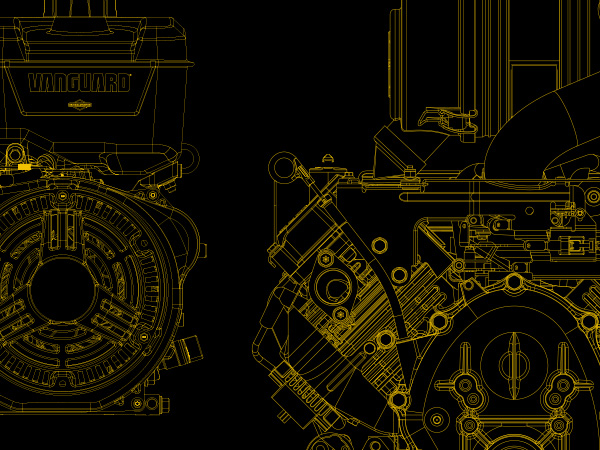Oil Recommendations
Recommendations Based On Temperature Conditions

*Below 40°F (4°C) the use of SAE 30 will result in hard starting and could cause a lack of lubrication failure.
**Above 80°F (27°C) the use of 10W30 may cause increased oil consumption. Check oil level more frequently.
.jpg)
- 15W-40 20 to 100+°F (-7 to 38+°C) is recommended for moderate to hot climates, ensuring reliable lubrication at higher operating temperatures.
%20(1).jpg)
- 20W-50 32 to 120+°F (0 to 49+°C) is best for high-temperature use, providing excellent protection under extreme heat and heavy loads.

- 5W-30 40°F and below (5°C and below) is recommended for winter use, and works best in cold conditions.

- SAE 30 40°F and higher (5°C and higher) is good for all purpose use above 40°F, use below 40°F will cause hard starting.
.jpg)
- 10W-30 0 to 100 °F (-18 to 38°C) is better for varying temperature conditions. This grade of oil improves cold weather starting, but may increase oil consumption at 80°F (27°C) or higher.
%20(1).jpg)
- Synthetic 5W-30 -20 to 120°F (-30 to 40°C) provides the best protection at all temperatures as well as improved starting with less oil consumption.
.jpg)
- For continuous-use, such as commercial lawn cutting or pressure washing, use Vanguard 15W-50 Oil (temperatures from 20°F to 130°F).
.jpg)
- 10W-40 0 to 100+°F (-18 to 38+°C) is good for varied temperatures, offering reliable cold starts and strong protection in hot conditions.
Type of oil to use
Use a high quality detergent oil classified "For Service SJ, SL, SM, SN" or higher.
Do not add additional additives.
Choose a viscosity according to the table above.
*NOTE: Briggs & Stratton engines are not designed to run on E85 fuel. E85 is a blend of 85% ethanol (alcohol) and 15% gasoline, which is not compatible with most engines intended to run on regular gasoline. While alcohol is an excellent octane booster, it delivers less power, having an energy value of only about 77,000 Btu per gallon versus 114,000 Btu for regular gasoline. E85 also demands a different fuel-to-air ratio to burn efficiently, requiring specially calibrated carburetors. Further, specially designed fuel system components are required to withstand the high alcohol concentration found in E85.
For additional information on fuel type, please download our Fuel Requirements PDF.
*NOTE: Briggs & Stratton engines are not designed to run on E85 fuel. E85 is a blend of 85% ethanol (alcohol) and 15% gasoline, which is not compatible with most engines intended to run on regular gasoline. While alcohol is an excellent octane booster, it delivers less power, having an energy value of only about 77,000 Btu per gallon versus 114,000 Btu for regular gasoline. E85 also demands a different fuel-to-air ratio to burn efficiently, requiring specially calibrated carburetors. Further, specially designed fuel system components are required to withstand the high alcohol concentration found in E85.
For additional information on fuel type, please download our Fuel Requirements PDF.
*NOTE: Briggs & Stratton engines are not designed to run on E85 fuel. E85 is a blend of 85% ethanol (alcohol) and 15% gasoline, which is not compatible with most engines intended to run on regular gasoline. While alcohol is an excellent octane booster, it delivers less power, having an energy value of only about 77,000 Btu per gallon versus 114,000 Btu for regular gasoline. E85 also demands a different fuel-to-air ratio to burn efficiently, requiring specially calibrated carburetors. Further, specially designed fuel system components are required to withstand the high alcohol concentration found in E85.
For additional information on fuel type, please download our Fuel Requirements PDF.
*NOTE: Briggs & Stratton engines are not designed to run on E85 fuel. E85 is a blend of 85% ethanol (alcohol) and 15% gasoline, which is not compatible with most engines intended to run on regular gasoline. While alcohol is an excellent octane booster, it delivers less power, having an energy value of only about 77,000 Btu per gallon versus 114,000 Btu for regular gasoline. E85 also demands a different fuel-to-air ratio to burn efficiently, requiring specially calibrated carburetors. Further, specially designed fuel system components are required to withstand the high alcohol concentration found in E85.
For additional information on fuel type, please download our Fuel Requirements PDF.
*NOTE: Briggs & Stratton engines are not designed to run on E85 fuel. E85 is a blend of 85% ethanol (alcohol) and 15% gasoline, which is not compatible with most engines intended to run on regular gasoline. While alcohol is an excellent octane booster, it delivers less power, having an energy value of only about 77,000 Btu per gallon versus 114,000 Btu for regular gasoline. E85 also demands a different fuel-to-air ratio to burn efficiently, requiring specially calibrated carburetors. Further, specially designed fuel system components are required to withstand the high alcohol concentration found in E85.
For additional information on fuel type, please download our Fuel Requirements PDF.
*NOTE: Briggs & Stratton engines are not designed to run on E85 fuel. E85 is a blend of 85% ethanol (alcohol) and 15% gasoline, which is not compatible with most engines intended to run on regular gasoline. While alcohol is an excellent octane booster, it delivers less power, having an energy value of only about 77,000 Btu per gallon versus 114,000 Btu for regular gasoline. E85 also demands a different fuel-to-air ratio to burn efficiently, requiring specially calibrated carburetors. Further, specially designed fuel system components are required to withstand the high alcohol concentration found in E85.
For additional information on fuel type, please download our Fuel Requirements PDF.
For your convenience, do-it-yourself parts and products can be purchased through the Briggs & Stratton online store.
To view the most current information regarding oil type and capacity, please view/print your engine Operator's Manual online. Engine Break-in procedures for both Synthetic and standard oil remain the same.

Note: Synthetic oil meeting ILSAC GF-2, API certification mark and API service symbol (shown at left) with "SJ/CF ENERGY CONSERVING" or higher, is an acceptable oil at all temperatures. Use of synthetic oil does not alter required oil change intervals.
MORE INFORMATION
Have more questions? Ask our new tool, Briggs & Stratton Assist for fast and accurate answers.
LOCATE A DEALER
Finding the right dealer is key to getting the right help. Our dealers are certified and specialize in selling or servicing our different product types.






